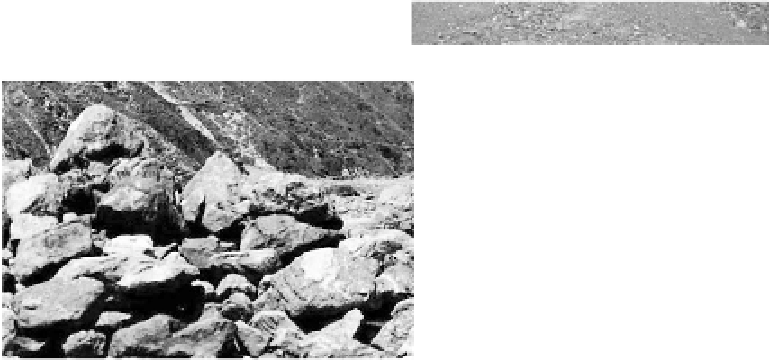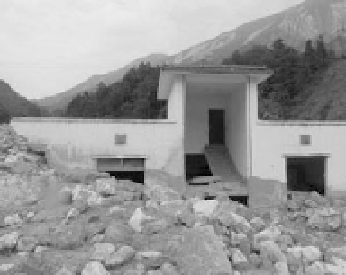Environmental Engineering Reference
In-Depth Information
because it stricken against but was not able to destroy the three story building, which was just located on
the path of the debris flow at the gully mouth. Local farmers told the authors that the velocity of the debris
flow was about walk speed of humans. It was due to the low velocity the debris flow was not very killing.
(a) (b)
(c) (d)
Fig. 4.31
(a) Deposits of a pseudo-one-phase debris flow in the Jiangjia Ravine on the Yunnan-Guizhou Plateau of
China; (b) Pseudo-one-phase debris flow mixture looks like concrete; (c) Deposits of a two-phase debris flow in
the Doufu Ravine; (d) Deposit of a two-phase debris flow in the Zoumaling Gully in the Mianyuan River basin in
Sichuan in 2008. A building in the gully was not destroyed by the debris flow because the velocity was low (See
color figure at the end of this topic)
As a comparison pseudo-one-phase debris flows had extremely high velocity and were very disastrous,
such as the large volume debris flow occurring in Zhouqu county on Aug. 7, 2010. There was no relative
movement between the solid particles and liquid within the debris flow and the flow energy only consumed
at the boundaries. The pseudo-one-phase debris flow had extremely high velocity. It was reported that the
highest velocity of a pseudo-one-phase debris flow in Peru was as high as 81 m/s (Browning, 1973). Such a
high velocity was not directly measured. In the Jiangjia Ravine in Yunnan, southern China, the velocity
of pseudo-one-phase debris flow was measured with a double radar velocimeter, which received high
frequency radio waves reflected from the head of debris flows. The highest velocity was measured at
26.8 m/s (Kang et al., 2004).
Pseodo-one-phase debris flow is a rheological flow. A rheological or constitutive equation relating
stress and strain is needed for the debris flows because the flow exhibit non-Newtonian behavior. For the
two-phase debris flows rheological equation is not enough to describe the flow behavior because there is
relative movement between the two phases and energy exchange between the two phases. Nevertheless,
some scientists simply use rheological equation to describe two-phase debris flows.










Search WWH ::

Custom Search